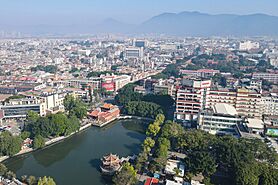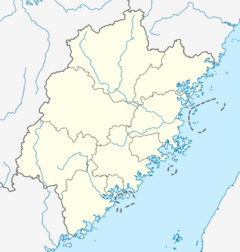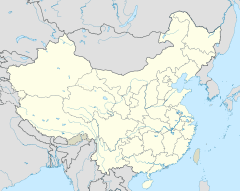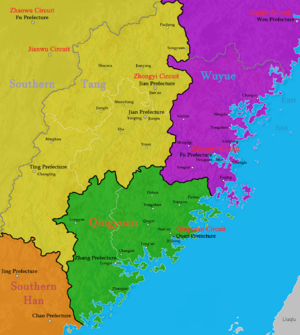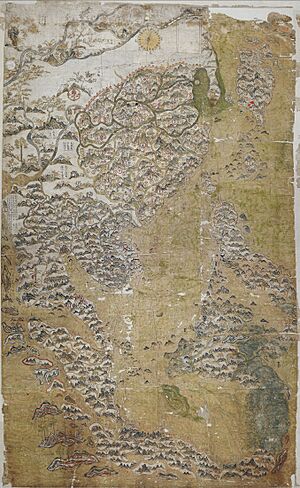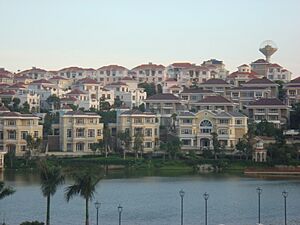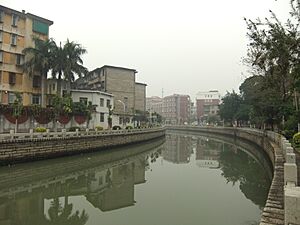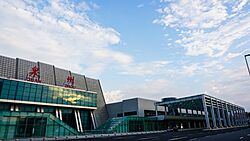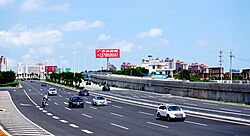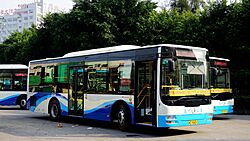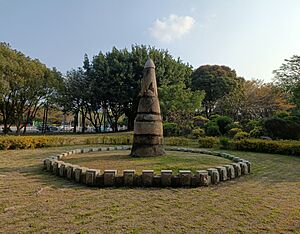Quanzhou facts for kids
Quick facts for kids
Quanzhou
泉州市
Chinchew
|
|||||||||||||||||||||||||||||||||||
|---|---|---|---|---|---|---|---|---|---|---|---|---|---|---|---|---|---|---|---|---|---|---|---|---|---|---|---|---|---|---|---|---|---|---|---|
|
Prefecture-level city
|
|||||||||||||||||||||||||||||||||||
|
Clockwise from top: Old City of Quanzhou, Zhangping–Quanzhou–Xiaocuo railway over the East Creek, Quanzhou Worker's Cultural Palace, Luoyang Bridge and Chaotian Gate.
|
|||||||||||||||||||||||||||||||||||
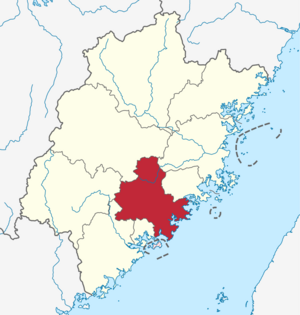 |
|||||||||||||||||||||||||||||||||||
| Administered by | People's Republic of China | ||||||||||||||||||||||||||||||||||
| Claimed by | Republic of China | ||||||||||||||||||||||||||||||||||
| PRC Province | Fujian | ||||||||||||||||||||||||||||||||||
| ROC Province | Fuchien | ||||||||||||||||||||||||||||||||||
| Municipal seat | Fengze District | ||||||||||||||||||||||||||||||||||
| Area | |||||||||||||||||||||||||||||||||||
| • Prefecture-level city | 11,218.91 km2 (4,331.65 sq mi) | ||||||||||||||||||||||||||||||||||
| • Urban | 872.4 km2 (336.8 sq mi) | ||||||||||||||||||||||||||||||||||
| • Metro | 4,274.5 km2 (1,650.4 sq mi) | ||||||||||||||||||||||||||||||||||
| Population
(2020 census)
|
|||||||||||||||||||||||||||||||||||
| • Prefecture-level city | 8,782,285 | ||||||||||||||||||||||||||||||||||
| • Density | 782.8109/km2 (2,027.4709/sq mi) | ||||||||||||||||||||||||||||||||||
| • Urban | 1,728,386 | ||||||||||||||||||||||||||||||||||
| • Urban density | 1,981.19/km2 (5,131.25/sq mi) | ||||||||||||||||||||||||||||||||||
| • Metro | 6,669,711 | ||||||||||||||||||||||||||||||||||
| • Metro density | 1,560.349/km2 (4,041.28/sq mi) | ||||||||||||||||||||||||||||||||||
| GDP | |||||||||||||||||||||||||||||||||||
| • Prefecture-level city | CN¥ 1.016 trillion US$ 147.3 billion |
||||||||||||||||||||||||||||||||||
| • Per capita | CN¥ 115,768 US$ 18,180 |
||||||||||||||||||||||||||||||||||
| Time zone | UTC+8 (CST) | ||||||||||||||||||||||||||||||||||
| Postal code |
362000
|
||||||||||||||||||||||||||||||||||
| Area code(s) | 0595 | ||||||||||||||||||||||||||||||||||
| ISO 3166 code | CN-FJ-05 | ||||||||||||||||||||||||||||||||||
| License Plate Prefixes | 闽C | ||||||||||||||||||||||||||||||||||
| Local Dialect | Hokkien/Min Nan: Quanzhou dialect | ||||||||||||||||||||||||||||||||||
|
|||||||||||||||||||||||||||||||||||
| Official name: Quanzhou: Emporium of the World in Song-Yuan China | |||||||||||||||||||||||||||||||||||
| Type: | Cultural | ||||||||||||||||||||||||||||||||||
| Criteria: | iv | ||||||||||||||||||||||||||||||||||
| Designated: | 2021 (44th session) | ||||||||||||||||||||||||||||||||||
| Reference #: | 1561 | ||||||||||||||||||||||||||||||||||
| Region: | China | ||||||||||||||||||||||||||||||||||
Quanzhou is a big port city in southern Fujian, China. It sits on the north bank of the Jin River, right next to the Taiwan Strait. It's the largest and most populated city region in Fujian.
In 2020, about 8.7 million people lived in Quanzhou. Its main urban areas include Licheng, Fengze, and Luojiang districts. It also includes cities like Jinjiang, Nan'an, and Shishi.
From the 11th to 14th centuries, Quanzhou was a very important port for traders from other countries. They called it Zaiton. Famous travelers like Marco Polo and Ibn Battuta visited. They both said it was one of the richest and most amazing cities in the world.
Quanzhou was a busy place with many different cultures. It had Buddhist and Hindu temples, Islamic mosques, and Christian churches. Because of its important history in sea trade and its many old buildings, UNESCO added "Quanzhou: Emporium of the World in Song-Yuan China" to its World Heritage List in 2021.
Contents
Understanding Quanzhou's Names
Quanzhou is also known as Zayton or Zaiton in older English books. This name comes from the city's Chinese name, 泉州. The name means "Spring Prefecture."
Other old ways to write its name include Ch'üan-chou and Chinchew. "Chinchew" was a common name used by European sailors. It might have come from a local way of saying the name of a nearby city, Zhangzhou.
The Arabic name Zaiton means "City of Olives." This name came from a Chinese nickname for the city. It was called "thorny tung tree city" because a ruler in the 10th century ordered many tung trees planted there. The word "satin" actually comes from "Zaitun."
Where is Quanzhou?
Quanzhou city is located on a piece of land between two rivers, the Jin River and the Luoyang River. These rivers flow into Quanzhou Bay, which is part of the Taiwan Strait.
The area around Quanzhou is quite hilly and mountainous. It's part of Fujian Province's Southern Coast region. To its south are Xiamen and Zhangzhou, and to its north is Putian.
Quanzhou's Weather
Quanzhou has a humid subtropical climate. This means it has warm, wet summers and mild winters. The temperature usually stays between 0 and 38 degrees Celsius (32 to 100 degrees Fahrenheit).
In the summer, typhoons sometimes hit the city. These storms bring a lot of rain and can cause some damage.
| Climate data for Quanzhou (Jinjiang, Fujian, 1991–2020 normals) | |||||||||||||
|---|---|---|---|---|---|---|---|---|---|---|---|---|---|
| Month | Jan | Feb | Mar | Apr | May | Jun | Jul | Aug | Sep | Oct | Nov | Dec | Year |
| Mean daily maximum °C (°F) | 16.8 (62.2) |
17.3 (63.1) |
19.6 (67.3) |
23.8 (74.8) |
27.3 (81.1) |
30.0 (86.0) |
32.7 (90.9) |
32.5 (90.5) |
31.0 (87.8) |
27.4 (81.3) |
23.6 (74.5) |
19.0 (66.2) |
25.1 (77.1) |
| Daily mean °C (°F) | 12.9 (55.2) |
13.2 (55.8) |
15.5 (59.9) |
19.8 (67.6) |
23.6 (74.5) |
26.7 (80.1) |
28.8 (83.8) |
28.6 (83.5) |
27.1 (80.8) |
23.6 (74.5) |
19.8 (67.6) |
15.2 (59.4) |
21.2 (70.2) |
| Mean daily minimum °C (°F) | 10.4 (50.7) |
10.7 (51.3) |
12.8 (55.0) |
17.0 (62.6) |
21.0 (69.8) |
24.4 (75.9) |
26.1 (79.0) |
25.9 (78.6) |
24.5 (76.1) |
20.8 (69.4) |
17.2 (63.0) |
12.6 (54.7) |
18.6 (65.5) |
| Average precipitation mm (inches) | 44.2 (1.74) |
72.7 (2.86) |
96.7 (3.81) |
106.4 (4.19) |
180.9 (7.12) |
206.2 (8.12) |
126.8 (4.99) |
193.1 (7.60) |
120.0 (4.72) |
48.4 (1.91) |
42.2 (1.66) |
43.5 (1.71) |
1,281.1 (50.43) |
| Average precipitation days (≥ 0.1 mm) | 6.9 | 9.7 | 13.4 | 12.9 | 14.5 | 13.8 | 8.8 | 11.1 | 8.1 | 3.6 | 4.9 | 6.3 | 114 |
| Average relative humidity (%) | 70 | 74 | 75 | 76 | 79 | 83 | 78 | 78 | 73 | 66 | 68 | 67 | 74 |
| Mean monthly sunshine hours | 138.0 | 113.0 | 124.4 | 142.7 | 156.3 | 180.7 | 265.1 | 229.5 | 202.5 | 199.4 | 157.5 | 146.7 | 2,055.8 |
| Percent possible sunshine | 41 | 35 | 33 | 37 | 38 | 44 | 64 | 58 | 55 | 56 | 48 | 45 | 46 |
| Source: China Meteorological Administration | |||||||||||||
Past Earthquakes
Quanzhou has experienced strong earthquakes in its history. Two major ones happened in 1394 and on December 29, 1604.
A Look at Quanzhou's History
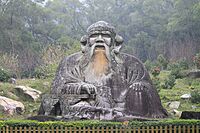
Early Beginnings
The area where Quanzhou is now was used as a base by Wang Guoqing in the late 500s AD. The city of Quanzhou itself was officially started in 718 during the Tang dynasty. It was built on a piece of land between two parts of the Jin River. Muslim traders came to the city early on, adding to their trade in other Chinese cities.
The Five Dynasties Period
During the Five Dynasties and Ten Kingdoms period, Quanzhou was part of the Min state. After Min fell, the Qingyuan Circuit became a mostly independent area. It lasted for 29 years (949-978) with Quanzhou as its capital.
The founder, Liu Congxiao, helped trade with other countries grow a lot. He also developed the city. Many Erythrina trees were planted, which is why Quanzhou was sometimes called "Erythrina City." In 978, the ruler Chen Hongjin gave up control to the Song dynasty to avoid war.
Quanzhou in the Song Dynasty
Quanzhou became very important for international trade in the early 1000s. It was the starting point of the Maritime Silk Road, which was a sea route for trade. This made it more important than the old land trade routes.
By 1120, about 500,000 people lived in the Quanzhou area. The city's trade helped its industries grow, like making ceramics, sugar, and salt. Quanzhou was one of the biggest and most diverse seaports in the world at this time.

Merchants from many places, including Arabia, India, and Japan, came to Quanzhou. A customs officer named Zhao Rugua wrote a book called Zhu Fan Zhi around 1225. It described the people, places, and goods involved in China's foreign trade.
Over time, Quanzhou's trade slowed down. This was due to problems with its trading partners and new rules from the Song government. Also, trade with Japan became more important for other Chinese ports.
The Yuan Dynasty Era
In 1277, under the Mongolian Yuan dynasty, a special office for foreign trade was set up in Quanzhou. A Muslim official named Pu Shougeng used his connections to help the city's trade recover. He was very successful, and Quanzhou became a great port again.
Marco Polo visited Quanzhou and said it was "one of the two greatest havens in the world for commerce." He called it the "Alexandria of the East." Ibn Battuta simply called it the greatest port in the world.
The Mongol invasions of Japan and Java mostly started from Quanzhou's port. In the 1320s, a friar named Odoric noted that the city had two Franciscan friaries. However, the Buddhist monasteries were much larger.
Between 1357 and 1367, a group of Muslim soldiers started a conflict against the Yuan dynasty. This led to a period of unrest in Quanzhou. In 1367, Yuan forces defeated the rebels. When the Yuan dynasty was overthrown in 1368, there was a period of violence against foreign communities and the family of Pu Shougeng. Many buildings with foreign styles were destroyed.
Ming and Qing Dynasties: Changes and Challenges
The Ming dynasty government didn't encourage foreign trade very much. By 1473, trade in Quanzhou had dropped a lot. The city's trade office had to close completely in 1522 because of Wokou (pirates).
During the Qing dynasty, rules that limited sea travel and trade hurt the city. Traders and fishermen had to stop going to sea for years. Coastal farmers were even forced to move inland.
From the 1800s to Today
In the 1800s, Quanzhou's city walls were still strong. However, sandbars in the rivers made it harder for large ships to reach the harbor. By the time of the First World War, the harbor was mostly unusable for big ships.
Even so, Quanzhou remained a large and successful city. It continued its sea trade through a nearby town called Anhai. After the Chinese Civil War, the Kinmen Islands became separate from Quanzhou.
How Quanzhou is Organized
Quanzhou is a prefecture-level city. It is divided into different areas for local government. These include four districts, three county-level cities, and four counties. There are also two special economic zones.
The People's Republic of China (Mainland China) claims the Kinmen Islands as part of Quanzhou. However, these islands are actually controlled by the Republic of China (Taiwan).
People and Culture
In 2010, Quanzhou had a population of over 8.1 million people. The main urban area had about 6.1 million residents.
Different Beliefs
Historically, Quanzhou was a very diverse city. It had temples for Chinese folk beliefs, Buddhism, Taoism, and Hinduism. There were also Islamic mosques and Christian churches.
The Qingjing Mosque was built in 1009 and is now a museum. The Buddhist Kaiyuan Temple has been rebuilt many times. It features two tall, 5-story pagodas from the 1200s.
A popular temple is the Guan Yue Temple. It honors Lord Yue and Lord Guan, who is known as the God of Martial Arts. Jinjiang also has the Cao'an Temple, which was originally built by Manicheans.
Local Language
People in Quanzhou speak the Quanzhou dialect of Hokkien. This is similar to the Amoy dialect spoken in Xiamen. It's also like the Hokkien spoken in Singapore, the Philippines, and Taiwan.
This dialect is very different from Mandarin Chinese. Many Chinese people living in other countries, especially in Southeast Asia, have ancestors from Quanzhou. They often speak Hokkien at home.
People Moving Away
Quanzhou has been a place where many Chinese people have left to live in other countries. These include countries in Southeast Asia and Taiwan. Some of these communities started a thousand years ago.
About 6 million overseas Chinese people today can trace their family roots back to Quanzhou. Most of them live in places like Singapore, the Philippines, Malaysia, and Indonesia.
Quanzhou's Economy
In the past, Quanzhou exported things like tea, camphor, sugar, and ceramics. Today, Quanzhou is a big exporter of farm products. These include tea, bananas, lychees, and rice.
It also produces a lot of granite and ceramics. Other important industries are textiles, footwear, and fashion. Quanzhou also makes packaging, machinery, paper, and petrochemicals.
Quanzhou's economy was the strongest in Fujian Province for 20 years, from 1991 to 2010. In 2008, Quanzhou made 10 percent of all clothing in China. It also produced 80 percent of China's sports and travel shoes. This means it made 20 percent of all such shoes in the world!
Quanzhou is known as China's "shoe city" today. Its 3,000 shoe factories make 500 million pairs of shoes every year. That's almost one out of every four pairs of sneakers made in China.
Cars and Roads
Quanzhou has the most private automobiles in Fujian. It is the biggest car market in the province. Major roads connect Quanzhou to Fuzhou in the north and Xiamen in the south.
Getting Around Quanzhou
Quanzhou is a key transportation center in southeastern Fujian. Many factories in inland Fujian send their goods to Quanzhou's ports for export. Quanzhou Port was very busy in the Tang dynasty and is still important today.
There is a passenger ferry that goes from Shijing, Nan'an, to the Kinmen Island. Kinmen is controlled by Taiwan.
Airport Travel
Quanzhou Jinjiang International Airport is the only airport in Quanzhou. It has flights to cities across mainland China. It also flies to other places in Southeast Asia, like Hong Kong, Macau, Manila, Kuala Lumpur, and Bangkok.
Major airlines operating here include Xiamen Air and Shenzhen Airlines.
Train Travel
Since 2010, Quanzhou has high-speed train service. This is part of the Hangzhou–Fuzhou–Shenzhen high-speed railway. High-speed trains stop at Quanzhou railway station and Jinjiang railway station.
You can get to Xiamen in under 45 minutes by train. This makes it easy for weekend trips. By 2015, direct high-speed trains were available to many cities in China.
Bus Services
Long-distance bus services also run daily or nightly from Quanzhou. You can take a bus to Shenzhen and other big cities. The main bus station operated from 1990 to 2020.
Colleges and Universities
Quanzhou has many places for higher education. Here are some of the colleges and universities:
- Huaqiao University (a national university)
- Quanzhou Normal University (public)
- Jinjiang Campus of Fuzhou University (public)
- Quangang Campus of College of Chemical Engineering, Fuzhou University (public)
- Anxi College of Tea Science (College of Digital Economy), Fujian Agriculture and Forestry University (public)
- Second School of Clinical Medicine, Fujian Medical University (public)
- Yang-en University (private)
- Minnan University of Science and Technology (private)
- Minnan Science and Technology College (private)
- Quanzhou University of Information Engineering (private)
- Jinjiang Campus of Fuzhou University Zhicheng College (private)
- Quangang Campus of Fuzhou University Zhicheng College (private)
- Jinshan College of Fujian Agriculture and Forestry University (Anxi) (private)
- Quanzhou Vocational and Technical University (vocational, private)
There are also several vocational schools:
- Liming Vocational University (public)
- Quanzhou Medical College (public)
- Quanzhou Preschool Education College (public)
- Fujian Electric Power Technical College (public)
- Quanzhou Vocational College of Economics and Business (public)
- Quanzhou Arts And Crafts Vocational College (public)
- Quanzhou Engineering Vocational and Technical College (private)
- Quanzhou College of Technology (private)
- Quanzhou Textile Garment Institute (private)
- Quanzhou Ocean Institute (private)
- Quanzhou Huaguang Vocational College (private)
Quanzhou's Culture
Quanzhou is known as one of China's 24 famous historic cultural cities. It has many unique cultural traditions:
- Liyuan Opera (梨园戏)
- Puppet Show (提线木偶戏)
- Gaojia Opera (高甲戏)
- Dacheng Opera (打城戏)
- Nanyin (南音), a music style that is very old
- Quanzhou Shaolin Five Ancestors Fist (泉州五祖拳)
- Yongchun martial arts
The city hosted the Sixth National Peasants' Games in 2008. Local foods include rice dumplings and oyster omelettes.
Places to Visit
There are many interesting historical and cultural sites in Quanzhou. Some of them are:
- Qing Yuan mountain (清源山) - This is the tallest hill in the city. It offers a great view of West Lake.
- East Lake Park (东湖) - Located in the city center, it has a small zoo.
- West Lake Park (西湖公园) - This is the largest freshwater area in the city.
- Scholar Street (状元街) - A street about 500 meters long, known for tourism and cultural crafts.
Modern cultural spots include:
- Fengze Square - A central city spot for shows and events.
- Dapingshan - The second tallest hill, with a huge statue of Zheng Chenggong.
- The Embassy Lounge - A place in the "1916 Cultural Ideas Zone" that mixes old Chinese art with modern designs.
You can learn about Quanzhou's past at the Maritime or Overseas-Relations History Museum. It has exhibits on old ships and tombstones. A very important exhibit is the "Quanzhou ship," an old ship found in 1973–74.
The old city center has "balcony buildings" (Chinese: 骑楼; pinyin: qílóu). This is a style of southern Chinese architecture from the early 1900s.
Famous People from Quanzhou
- Li Nu, a merchant and scholar.
- Zhang Wenyu, a nuclear physicist born in Hui'an.
- Lin Junde, an explosion mechanics scientist born in Yongchun.
- Xie Xide, a physicist born in Shishi, who was also a university president.
- Guo Guangcan, a quantum physicist born in Hui'an.
- Yao Chen, a famous actress born in Shishi.
Villages
- Xunpu
Images for kids


